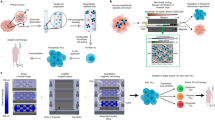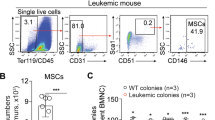Abstract
We have developed a new BMT method, intra-BM-BMT (IBM-BMT), in which donor BM cells (BMCs) are directly injected into the recipient’s BM, resulting in a rapid recovery of donor hematopoiesis and a reduction in the severity of GVHD. In the present experiment, we attempted to retain the number of injected BMCs using magnetic beads and a magnet. The BMCs of donor mice were conjugated with magnetic beads, and these cells were then injected into the BM of recipient mice with a magnet (magnet-IBM group) and compared with conventional IBM-BMT without a magnet (IBM group). A significantly higher number of transplanted cells were detected in the injected BM in the magnet-IBM group. We next carried out day-12 colony-forming units of spleen (CFU-S) assays to examine the early stage of hematopoiesis of the injected host hematopoietic stem cells after IBM-BMT. The spleens of mice in the magnet-IBM group showed considerably higher CFU-S counts than those in the IBM group. Excellent reconstitution of donor hematopoietic cells in the magnet-IBM group was observed 1 month after IBM-BMT. These results suggest that the IBM-BMT using the combination of magnetic beads and a magnet is superior to the conventional IBM-BMT.
This is a preview of subscription content, access via your institution
Access options
Subscribe to this journal
Receive 12 print issues and online access
$259.00 per year
only $21.58 per issue
Buy this article
- Purchase on Springer Link
- Instant access to full article PDF
Prices may be subject to local taxes which are calculated during checkout




Similar content being viewed by others
References
Wujcik D, Ballard B, Camp-Sorrell D . Selected complications of allogeneic bone marrow transplantation. Semin Oncol Nurs 1994; 10: 28–41.
Poliquin CM . Post-bone marrow transplant patient management. Yale J Biol Med 1990; 63: 495–502.
Auletta JJ, Lazarus HM . Immune restoration following hematopoietic stem cell transplantation: an evolving target. Bone Marrow Transplant 2005; 35: 835–857.
Novitzky N, Davison GM . Immune reconstitution following hematopoietic stem-cell transplantation. Cytotherapy 2001; 3: 211–220.
Wingard JR . Opportunistic infections after blood and marrow transplantation. Transpl Infect Dis 1999; 1: 3–20.
Kushida T, Inaba M, Hisha H, Ichioka N, Esumi T, Ogawa R et al. Intra-bone marrow injection of allogeneic bone marrow cells: a powerful new strategy for treatment of intractable autoimmune diseases in MRL/lpr mice. Blood 2001; 79: 3292–3299.
Ikehara S . New strategies for BMT, organ transplantation, and regeneration therapy. Hematology 2003; 8: 77–81.
Ikehara S . New strategies for BMT and organ transplantation. Int J Hematol 2002; 76 (Suppl 1): 161–164.
Li Q, Hisha H, Yasumizu R, Fan TX, Yang GX, Li Q et al. Analyses of very early hemopoietic regeneration after bone marrow transplantation: comparison of intravenous and intrabone marrow routes. Stem Cells 2007; 25: 1186–1194.
Esumi T, Inaba M, Ichioka N, Kushida T, Iida H, Ikehara S . Successful allogeneic leg transplantation in rats in conjunction with intra-bone marrow injection of donor bone marrow cells. Transplantation 2003; 76: 1543–1548.
Kaneda H, Adachi Y, Saito Y, Ikebukuro K, Machida H, Suzuki Y et al. Long-term observation after simultaneous lung and intra-bone marrow-bone marrow transplantation. J Heart Lung Transplant 2005; 24: 1415–1423.
Okazaki S, Hisha H, Mizokami T, Takaki T, Wang X, Song C et al. Successful acceptance of adult liver allografts by intra-bone marrow-bone marrow transplantation. Stem Cells Dev 2008; 17: 629–639.
Shi M, Adachi Y, Shigematsu A, Koike-Kiriyama N, Feng W, Yanai S et al. Intra-bone marrow injection of donor bone marrow cells suspended in collagen gel retains injected cells in bone marrow, resulting in rapid hemopoietic recovery in mice. Stem Cells 2008; 26: 2211–2216.
Wiesneth M, Schreiner T, Friedrich W, Müller S, Maccari B, Erne E et al. Combined CD34 positive plus CD2 negative selection for effective T-cell depletion as GvHD-prophylaxis in HLA-nonidentical blood progenitor cell transplantation. Transfus Sci 1996; 17: 629–635.
Cai JY, Tang YJ, Jiang LM, Pan C, Chen J, Tang JY . Prognostic influence of minimal residual disease detected by flow cytometry and peripheral blood stem cell transplantation by CD34+ selection in childhood advanced neuroblastoma. Pediatr Blood Cancer 2007; 49: 952–957.
Okabe M, Ikawa M, Kominami K, Nakanishi T, Nishimune Y . ‘Green mice’ as a source of ubiquitous green cells. FEBS Lett 1997; 407: 313–319.
Wang YB, Ogawa Y, Doi H, Kusumoto K, Jin TN, Ikehara S . Long-term immunologic induction of donor-specific tolerance to skin allografts by bone marrow transplant in rabbits. Plast Reconstr Surg 2003; 111: 291–297.
Suzuki Y, Adachi Y, Minamino K, Zhang Y, Iwasaki M, Nakano K et al. A new strategy for treatment of malignant tumor: intra-bone marrow-bone marrow transplantation plus CD4-donor lymphocyte infusion. Stem Cells 2005; 23: 365–370.
Taira M, Inaba M, Takada K, Baba S, Fukui J, Ueda Y et al. Treatment of streptozotocin-induced diabetes mellitus in rats by transplantation of islet cells from two major histocompatibility complex disparate rats in combination with intra bone marrow injection of allogeneic bone marrow cells. Transplantation 2005; 79: 680–687.
Baba S, Inaba M, Iwai H, Taira M, Takada K, Hisha H et al. Intra-bone marrow-bone marrow transplantation facilitates hemopoietic recovery including dendritic cells. Immunobiology 2005; 210: 33–42.
Takada K, Inaba M, Ichioka N, Ueda Y, Taira M, Baba S et al. Treatment of senile osteoporosis in SAMP6 mice by intra-bone marrow injection of allogeneic bone marrow cells. Stem Cells 2006; 24: 399–405.
Calvi LM . Osteoblastic activation in the hematopoietic stem cell niche. Ann N Y Acad Sci 2006; 1068: 477–488.
Porter RL, Calvi LM . Communications between bone cells and hematopoietic stem cells. Arch Biochem Biophys 2008; 473: 193–200.
Meirelles Lda S, Nardi NB . Murine marrow-derived mesenchymal stem cell: isolation, in vitro expansion, and characterization. Br J Haematol 2003; 123: 702–711.
Baddoo M, Hill K, Wilkinson R, Gaupp D, Hughes C, Kopen GC et al. Characterization of mesenchymal stem cells isolated from murine bone marrow by negative selection. J Cell Biochem 2003; 89: 1235–1249.
Acknowledgements
We thank Ms Y Tokuyama, Ms K Hayashi and Ms A Kitajima for their expert technical assistance, and also Mr Hilary Eastwick-Field and Ms K Ando for the preparation of this manuscript. This work was supported by a grant from the ‘The 21st Century COE Program’ of the Ministry of Education, Culture, Sports, Science and Technology, the Department of Transplantation for Regeneration Therapy (sponsored by Otsuka Pharmaceutical Company, Ltd), Molecular Medical Science Institute, Otsuka Pharmaceutical Co., Ltd, Japan Immunoresearch Laboratories Co., Ltd (JIMRO), Scientific Research (C) 21590447 and an award from Dr Toshiko Kitanishi.
Author information
Authors and Affiliations
Corresponding author
Ethics declarations
Competing interests
The authors declare no conflict of interest.
Rights and permissions
About this article
Cite this article
Shima, C., Adachi, Y., Shi, M. et al. The combination method using magnetic beads and a magnet helps sustain the number of donor BM cells after intra-BM injection, resulting in rapid hematopoietic recovery. Bone Marrow Transplant 45, 993–999 (2010). https://doi.org/10.1038/bmt.2009.278
Received:
Revised:
Accepted:
Published:
Issue Date:
DOI: https://doi.org/10.1038/bmt.2009.278



